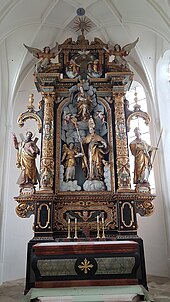Pilgrimage Church of St. Ulrich (Mühldorf)
The late Gothic branch church of St. Ulrich in the Petershausen district of Mühldorf in the Dachau district was built in the late 15th century and was a pilgrimage church until secularization . It belongs to the parish Hohenkammer in the neighboring district of Freising .
history
The elegant church was built around 1485. This is indicated by the two bells cast in 1486 and the keystone with the coat of arms of the Freising Bishop Sixtus von Tannberg (1473–1495). When the pilgrimage to Ortisei in Mühldorf began is unknown, as there is no evidence. At the time of Freising Prince-Bishop Veit Adam von Gepeckh (1618–1651 in office) it was found that several pilgrimages were taking place after Mühldorf, but they only reached their heyday in the 17th and 18th centuries.
In the second half of the 17th century the church received a new altar equipment: a high altar from 1656/58 and two side altars from 1695 with the altar paintings of Mary and the 14 Holy Helpers and the Holy Blood Savior . A second gallery was built in 1732 for a new organ from Dachau organ builder Quirin Weber. Because of the installation of a larger work by Peter Moser, the gallery had to be lowered in 1838. This organ was removed from the church in 1974, the second gallery dismantled around 1975. In 1735 the sacristy was added to the east wall of the choir. In 1798 a thunderstorm ruined the tower dome, which was then repaired. In the 19th century, the altars were heavily changed in line with historicism , these changes were reversed in 1911 - except for the side altars.
In 1791 the church roof was repaired, in 1823 the furnishings were redesigned and in 1980/82 the reredos from the side altars were removed. Exterior renovations took place from 1987–1991 and 2013 after a storm damage.
description
The perfectly shaped late Gothic hall consists of a three-bay nave and a retracted two-bay choir that closes on three sides. The tower, adorned with Gothic red ornamentation, which is square in the lower part, rises octagonally over two floors and ends with eight gables in a high, shingle-covered pointed roof. The well-proportioned exterior is supported by buttresses. Inside, the wall services take up the high-quality mesh vault with numerous keystones.
Furnishing
The high altar, which stands at the transition from early to high baroque, was created in 1656/58 by the Munich court sculptor Constantin Pader . In the reredos, the larger than life Saint Ulrich stands on a bank of clouds; an angel holds his attribute, a fish. After her coronation by the Holy Trinity, which is represented in the excerpt , Mary floats above it towards the saint. On the outside of the ornate columns stand on consoles under canopies the Saints Erasmus and Andrew. In 1878 the altar was dismantled in favor of a historical interior, the assistant figures were used for new side altars. In 1911 the high altar was reconstructed.
The former baroque side altar painting from 1685, which shows the Fourteen Holy Helpers , hangs on the southern choir wall, and on the archway there is an early Baroque triumphal cross, which was decorated with new figurative decorations by the Freising court sculptor Franz Anton Mallet in 1713 . The side altars (1877–1878) today only consist of the cafeteria and predella with a base in the middle bearing the figures of Saints Anthony (right) and Francis (left). The altars, which represent a mix of neo-Romanesque and neo-Gothic styles, were created by Balthasar Kraft. The figures have only been on the consoles since the 1980s. The pulpit (1860/80) on the north side of the nave is in the neo-Gothic style. The pulpit is decorated with tracery and vines. On the back wall of the pulpit is the picture of the Holy Blood Savior from the distant baroque side altar. The sound cover has a simple tracery wreath.
The brightly painted keystones on the excellent ribbed vault show, among other things, the coat of arms of the Lords of Kammer, from the Partheneck family, the Freising Bishop Sixtus von Tannberg (1473 / 74–1495), the coat of arms of Wolfgang Freiherr v. Weichs, pastor in Hohenkammer and canon of Freising (1473–1490), as well as the prince-bishop's insignia. The three eastern keystones are marked with a cross symbolizing faith, an anchor for hope and a heart for love. On the middle walls of the nave there are the saints of Leonhard (right) and St. Egidius (left) on consoles; these, like the side altar figures, are remnants of the high baroque side altars (1695) by Hans-Christoph Thalhammer. The renaissance gallery rests on two twisted wooden columns with stone plinths. Tendrils and spiral patterns, which look like inlaid work, from the late 16th century are painted on the parapet as red and blue stencils.
literature
- Rudolf George: Churches of the parish Hohenkammer (= Small Art Guide No. 1323). Schnell & Steiner, Munich 1981.
Web links
Coordinates: 48 ° 24 '55.1 " N , 11 ° 29' 59.8" E




